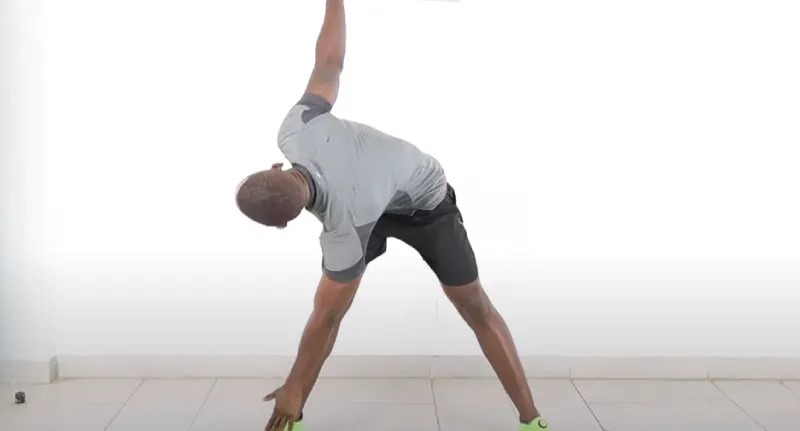When you cycle without dynamic stretching, your muscles and joints tighten, affecting your performance and causing fatigue. Cycling becomes uncomfortable and painful without dynamic stretching, making you less active.
Dynamic stretches for cycling include walking lunges, walking knee grabs, and walking piriformis stretches.
These stretches involve progressive movements that use momentum to extend the muscle groups. Do them before cycling to warm your muscles, get blood flowing, and prepare the joints for repetitive training.
In this blog post, we will explore cycling dynamic stretching, the benefits of cycling dynamic stretching, and types of cycling dynamic stretching.
Dynamic Stretches For Cycling: 6 Key Safety Tips

It still requires good fitness and mobility to prevent injuries and achieve optimal results. Incorporating dynamic stretches into your pre-ride routine is an excellent way to prepare your body for the demands of cycling. Here are some of the top benefits of dynamic stretching for cyclists:
Improved Flexibility
Cycling is a great way to stay in shape, but it can also cause tight muscles and decreased flexibility, especially in the hamstrings and hip flexors.
✔ Top Pick: Hip Flexor Stretching Band
Many cyclists use a stretching band to target tight hip flexors and reduce stiffness before riding.
Dynamic stretches can help address these issues by increasing the flexibility of these muscles, promoting a more excellent range of motion, and reducing stiffness during rides.
Increased Range of Motion
Cycling requires a full range of motion in the legs, hips, and core, and dynamic stretches are an excellent way to warm up these areas before a ride. The body is moved in a range of motions during dynamic stretches, preparing the muscles for longer and more powerful rides.
Reduced Risk of Injury
Cycling can be a high-impact sport, and injuries can happen to even experienced cyclists. Incorporate dynamic stretches into your pre-ride preparation to reduce injury risks.
With increased flexibility and range of motion for key muscles, dynamic stretches can prevent muscle pulls, strains, and other damage.
Enhanced Circulation and Blood Flow
Before every ride, promoting circulation throughout your body is essential to ensure the muscles receive the oxygen and nutrients they need. Dynamic stretches encourage this by warming the muscles and increasing circulation, enabling a better ride and faster recovery.
✔ Top Pick: Compression Leg Sleeves
Many cyclists use compression leg sleeves to boost circulation and support muscle performance.
Improved Coordination and Balance
Cycling requires excellent coordination and balance. Dynamic stretches can help improve these skills before a ride. Dynamic stretches promote better coordination and balance by encouraging the body to move in various ways, improving overall performance.
6 Types of Dynamic Stretches for Cycling
Before hitting the road, it’s crucial to warm up and stretch your muscles properly. Dynamic stretches can help prevent injury and enhance your performance by increasing flexibility, mobility, and blood flow. Here are some dynamic times that can help get you ready for your next cycling adventure:
Leg Swings
Leg swings are a great way to increase your hip mobility and flexibility. Start by standing up straight and facing a wall or sturdy object. Then, swing your left leg forward and backward, keeping your leg candidly and engaging your core. Do this for 10 reps, and then switch to your right leg.
Lunge with a Twist
This dynamic stretch stretches your hip flexors, glutes, and lower back while improving your balance. Start by taking a long step forward with your left leg and bending your knee into a lunge position.
Effortlessly rotate your torso to the left and extend your left arm towards the ceiling. Hold for a few seconds, then switch your legs.
High Knees
High knees are excellent for warming up your quads, hamstrings, and hip flexors. Start by jogging in place and lifting your knees as high as possible. Rest for 10 seconds after doing this for 30 seconds. Repeat this process for 2-3 times.
Butt Kicks

Butt kicks are another fantastic exercise for warming up your hamstrings and improving your running form. Get started by jogging in place and kicking your heels up towards your buttocks.
Straight Leg Marches
Straight leg marches are dynamic stretches that target your hamstrings and hip flexors while improving your balance. Start by standing up straight with your feet hip-width apart.
Lift your left leg straight out in front of you while keeping your leg straight and engaging your core. Then, slowly bring your left leg down and repeat with your right leg.
Ankle Bounces
Ankle bounces are a great way to warm your ankles, calves, and feet. Start by standing on one foot and bouncing up and down on the ball of your foot. Do this for 30 seconds, and then repeat with your other foot.
✔ Top Pick: Ankle Support Brace
Many cyclists use an ankle support brace to stabilize joints and prevent strain during warm-ups.
6 Precautions for Dynamic Stretching for Cyclists
Dynamic stretching is crucial for cyclists’ pre-workout routine. It involves movement and improves range of motion, preparing the body for physical activity.
However, it can lead to injury if not done correctly. Here are some precautions to consider when performing dynamic stretching before cycling.
Don’t Overstretch
People need to work on performing dynamic stretches to avoid overstretching their muscles. Overstretching can lead to strains, sprains, and other injuries.
Warm-up Gradually
Dynamic stretching should never be the first thing you do when you start a cycling workout. Keep warm up gradually by creating low-intensity exercises before moving on to dynamic stretching.
Focus on Proper Form
Correct form is crucial while performing dynamic stretches. Execute each stretch with good posture and proper alignment to avoid injury.
Start Slowly
You should begin slowly and gradually increase the strength and intensity of your stretches. You must do this to familiarize your muscles with dynamic stretching movements.
Avoid Bouncing

Bouncing while dynamic stretching can lead to muscle strains and tears. Ensure that all movements are smooth and controlled.
Listen to Your Body
Be mindful of your body and listen to its cues. If you experience discomfort or pain during stretching, quit immediately and seek medical attention.
Conclusion
Dynamic stretching is a powerful tool for cyclists looking to take their fitness to the next level. Whether you want to increase your endurance, improve your flexibility, or reduce your risk of injury, dynamic stretches can help you reach your goals.
By making dynamic stretches a regular part of your cycling routine, you’ll see improved performance and reduced muscle strain or injury risk. So, if you’re ready to take your cycling to the next level, try dynamic stretches and see the results yourself.
How Often Should I Incorporate Dynamic Stretches Into My Cycling Routine?
Dynamic stretches should be included in your warm-up routine before every cycling session. This ensures you’re prepared for the physical demands of cycling and ready to perform at your best. Dynamic stretching as part of your post-workout routine can also improve muscle recovery and reduce soreness.
How Long Should I Do Dynamic Stretches Before Cycling?
Aim to do dynamic stretches for about 10-15 minutes before cycling. This will give your body enough time to warm up and loosen stiff muscles.


